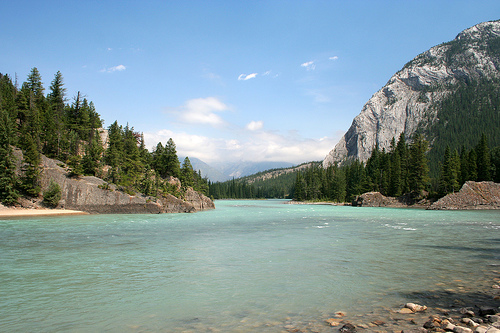In 2010, the Bow River Project Research Consortium was established to explore options for re-managing the river system from headwaters to confluence- the Bow River Project (BRP). Participants worked with an interactive, hydrologic simulation model to develop plausible and achievable scenarios for protecting the health of the river throughout the basin and meeting the needs of water users. The fully functioning, data-loaded Bow River Operational Model (BROM) is a very significant output of this project that will be publicly available for further analysis of the Bow River System and can be adapted for other river systems in Alberta.
The key results of this project and the opportunities it identifies support the goals and principles of other major policy documents and approaches, including the “Water for Life” strategy, the Calgary Metropolitan Plan, and the South Saskatchewan Regional Plan being developed under the Land-use Framework. The Consortium’s work shows that improvements in managing the Bow River System are realistic and doable with minimal economic impact on power generation revenues.
Five specific opportunities were identified for consideration by the Government of Alberta and others with a stake in the way the Bow River System is used and managed:
There were four alternative scenarios developed during the BRP to illustrate the effectiveness of the model at modelling potential operational or physical changes to the system. These scenarios were used to highlight any economically achievable improvements for the aquatic environment, water accessibility for human use, and to accommodate long-term economic development and population growth within the basin.
Scenario 3 was the Consortium’s Preferred Scenario. Details of all four scenarios are in the BRP final report. The Preferred Scenario includes:
The results of this project demonstrate that integrated management of the Bow River from headwaters to confluence could realize the following benefits:

After the release of the final report from the BRP work in 2010, BROM was used to assess climate change impacts on the system, and to refine the preferred operations scenario identified in the BRP 2010 final report.
Assessing Climate Change Impacts on Operational Flows in the Bow River Basin
In June 2011, work was undertaken and funded by WaterSMART to perform an initial assess of potential climate change impacts in the Bow River Basin, and how changes in climate could impact Bow River operations.
Three methods of applying climate scenarios from a range of climate forecasts based on wet, median, and dry conditions were selected to provide estimates of potential impacts that changes in climate could have on flows and operations in the Bow River Basin. The work was finished in November 2011 and concluded that the preferred operating scenario, identified in the BRP, resulted in better flows during the key months of the year when compared to current operating rules under the stresses of the climate scenarios.
In October 2011, the same group of individuals who worked on the BRP and developed the BROM, met again to test the impacts of their recommendations through a live simulation (the Simulation) using the BROM. This Simulation enabled participants to perform a realistic test of existing operations and to see the real-time operational impacts of their management choices.
The Simulation confirmed a number of the key recommendations put forward through the BRP to improve aquatic health and to make effective use of a water bank to manage the timing of downstream flows. In essence, the Simulation confirmed that the Bow River system can and should be managed differently to foster innovation and achieve many economic, environmental and social goals throughout the Bow basin. Participants concluded that the BROM is a realistic model and a valuable tool for understanding the river system and exploring changes and potential opportunities to manage the system better. Additional refinements and improvements to the BROM were identified and proposed as a result of the Simulation.
Integrated management would optimize opportunities for licence holders, the environment and other users along the entire system. The collaborative approach used in this project and the resulting tool—the Bow River Operational Model—exemplify the importance and value of knowledgeable stakeholders working together, with access to agreed-upon data. The Consortium believes that successfully managing the Bow River System in an integrated fashion will require a shared approach involving the key water managers and users of this vital resource.
This approach and process can be applied to other basins, to help identify changes to river systems that can benefit the watershed. The hope is to expand this work to the entire South Saskatchewan River Basin (SSRB). A proposed work plan will, through the use of a suite of existing analytical and fit-for-purpose decision support tools, create the capacity for an informed, collaborative and adaptive management approach to water resource management in the SSRB. This approach will enable organizations, communities and individuals to determine their most suitable response to changes in the basin, including changes in climate, within the physical realities of the SSRB river flows, requirements and infrastructure.
Bow River Project
Final Report- Part 1
Bow River Project
Final Report- Part 2
Bow River Project
Final Report- Part 3
Bow River Project
Final Report- Part 4
Bow River Project
Final Report- Part 5
Bow River Project
Final Report- Part 6
Bow River Project – Final Report Appendix A B C- Part 2
We provide Canadian educational resources on water practices to promote conservation and sustainability. Our team crafts current and relevant content, while encouraging feedback and engagement.
The Canada WaterPortal is a registered charity, #807121876RR0001
We recognize and respect the sovereignty of the Indigenous Peoples and communities on whose land our work takes place.
© 2025 All Rights Reserved.